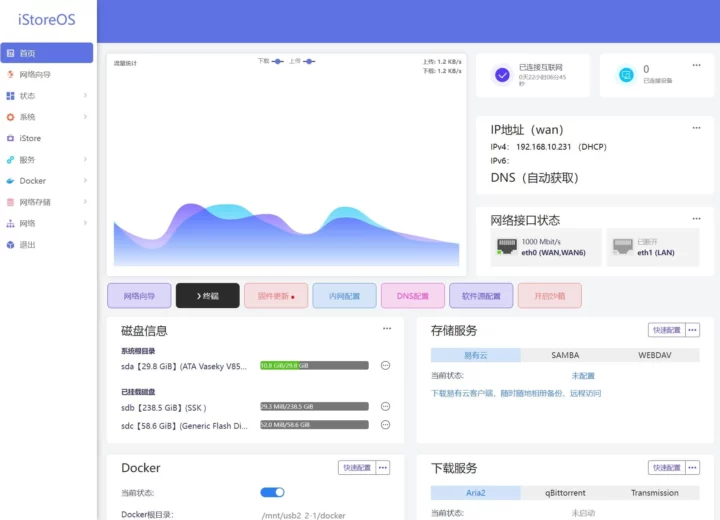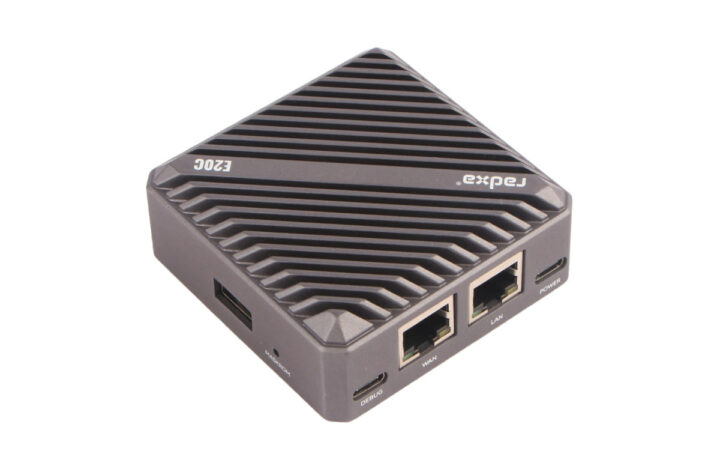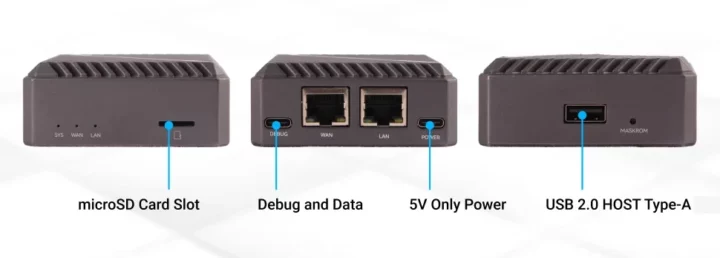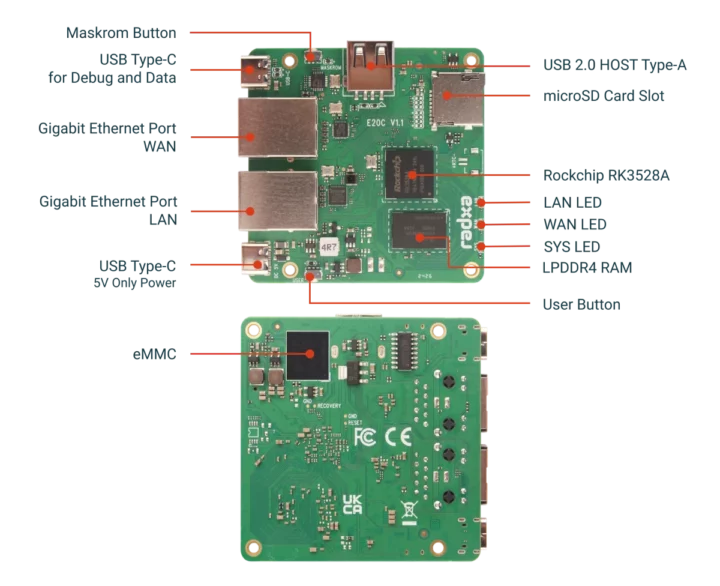Radxa ROCK E20C, also “dubbed Mini Network Titan”, is a router with dual Gigabit Ethernet, a USB 2.0 host port, and a microSD card slot powered by a Rockchip RK3528A quad-core Cortex-A53 processor clocked at 2.0 GHz.
Housed in a CNC aluminum alloy case, the ultra-compact fanless router is offered with 1GB to 4GB LPDDR4 memory, 8GB to 32GB eMMC flash, and also exposes two USB-C ports, one for power and the other for serial console access without having to tear down the device.
Radxa ROCK E20C specifications:
- Processor – Rockchip RK3528A
- CPU – Quad-core Arm Cortex-A53 @ 2.0 GHz
- GPU – Arm Mali-G450 GPU with support for OpenGL ES1.1, ES2.0, and OpenVG 1.1 APIs
- VPU
- H.264, H.265, and AVS2 decoder up to 4Kp60
- H.264 and H.265 encoder up to 1080p60
- NPU – 1 TOPS NPU (TBC)
- Memory – 1GB, 2GB, or 4GB LPDDR4
- Storage
- 8GB, 16GB, or 32GB eMMC flash
- MicroSD card slot
- Networking – 2x gigabit Ethernet RJ45 ports
- USB – 1x USB 2.0 Type-A port, 1x USB 2.0 Type-C for serial and data
- Debugging – USB-C port for serial console access
- Misc
- User button
- Maskrom pinhole
- WAN, LAN, and System LEDs
- Power Supply – 5V DC via USB Type-C port
- Dimensions – 67 x 67 x 15 mm
- Temperature Range – Recommended: 0 to 50°C; Note the Radxa E20C’s CPU has a temperature limit of 80°C and beyond that it throttles clock speeds for reliability
The hardware design and features are similar to the LinkStar H28K travel router, but the latter features a 1.5 GHz Rockchip RK3528, while the ROCK E20C is based on a more powerful 2.0 GHz Rockchip RK3528A SoC with the same features and a higher CPU frequency. The ROCK EC20C is also slightly larger, comes with a USB-C port for debugging, and offers more options in terms of RAM/storage configuration.
Software-side, it’s also more versatile with support for Debian with XFCE, Flippy OpenWrt, and iStoreOS, another fork of OpenWrt with a user interface that aims to simplify the configuration process, features the iStore app store for OpenWrt, and also acts as a lightweight NAS software. You’ll find resources to get started, download links for the OS images, and documentation on the wiki.

Radxa sells the Radxa E20C router on AliExpress for $27.88 and up with the final price depending on the selected configuration (and taxes). The 1GB/8GB, 2GB/16GB, and 4GB/32GB models are available on AliExpress, but stocks are limited. Note the power supply is not included by default. You’ll also find the “Mini Network Titan” on Arace Tech, but right now only 1GB and 2GB RAM models are available. Further details may be found on the product page.

Jean-Luc started CNX Software in 2010 as a part-time endeavor, before quitting his job as a software engineering manager, and starting to write daily news, and reviews full time later in 2011.
Support CNX Software! Donate via cryptocurrencies, become a Patron on Patreon, or purchase goods on Amazon or Aliexpress








I’m still waiting for a dual-2.5G + eMMC + console in this form factor. The closest to this is the R5C from FriendlyElec but it lacks the console and I’m really pissed off with drilling holes in enclosures and gluing boards inside to keep access to the boot loader to choose the kernel to boot from upon upgrades or fixup IP configuration. Ideally an RK3568 would be great since it has full mainline support, has good performance and requires little power.
I actually connected a bluetooth 3.0 Serial Port Profile module to the header inside my Slate AR750S, so I can now access the serial console without having to open it up. Might not work too well through a metal case, though!
And yes, you can access u-boot, but only if you can reboot/reset the device without losing power to the bluetooth module. So, not quite a solution if you are trying to bring up the device, unless you set the boot timeout to something relatively long, like say 5 seconds, to allow you to pair with the bluetooth module as it boots, then connect to the bluetooth serial port and press a key.
It might be plausible to use the “User button” to drop into the u-boot console if pressed at boot time, perhaps?
I honestly don’t know, but I’m really done with console-less devices. Too many issues, too much fear of updating, too long outages when in prod, etc. This just reminds me that I own a very neat StationPC-M1. It took two weeks with RK’s support to try to unbrick it due to their bogus flashing tool sending the eMMC image to the NOR. Each time I needed to make a test to give them info, I had to reconnect wires to the 40-pin header. I couldn’t just bring it with me everywhere to quickly test on my desk at work by plugging a USB cable for example. And that’s far from being the worst one…
I’ll wait for either Radxa to produce a dual-port 2.5G variant of this device (ideally using RK3568 so that mainline works out-of-the-box, Tom if you read this…) or FriendlyELEC to finally add a console port to R5S that’s only missing exactly this to sell.
Swappable emmc would be top notch 🙂
True, but for a router you generally don’t care, you take the 1GB RAM model with just enough flash for your OS of choice and generally it goes into production until it dies!
@willy check out radxa e25. Only downside is that the usb-c is also used for power and serial
It must be a new revision, because the USB-C port could not be used for that purpose when I received mine: https://www.cnx-software.com/2022/01/22/radxa-e25-carrier-board-2-5gbe-switch-and-wifi-6-router/#radxa-e25-board
Edit: yes… My board was v1.3 with a 4-pin UART header, but v1.4 does without the UART header, and supports serial via the USB-C port.
That’s great to read! I, too, was still at the “usb for power only” step regarding E25. Unfortunately, their wiki is full of 404 when clicking on links 🙁
I found it in the “Network Computer” section on the site. There’s indeed an updated schematics showing “power+uart”, so while it’s a significant improvement, it still means you can’t just connect without rebooting. But at least it saves you from having to take the screw driver. And there are USB-C Y cables for power injection out there which should address this point.
But I agree that it seems to have everything to make a 2.5G router. I’ll check if I find a reasonably priced one (including shipping).
> Networking – 2x gigabit Ethernet RJ45 ports
Schematics hopefully answer the question how those two ports are realized:
one port internal MAC with external RGMII attached RTL8211F PHYthe other port provided by a PCIe Gen2 x1 attached RTL8111H
> similar to the LinkStar H28K travel router, but the latter features a 1.5 GHz Rockchip RK3528
That was able to perform at 2.0 GHz flawlessly when being benchmarked last October: https://github.com/ThomasKaiser/sbc-bench/blob/master/Results.md
Price on Aliexpress seems to have gone up.
The price has not changed here, but if you are based in Europe you’ll be charged VAT too.
The board is pretty new (even the processor RK3568 is not). For a debian image I can’t find all the packages which can be found on a base debian distribution (only few of them are compiled by the producer). In my opinion who want to use this board should wait a few years.
Note, it’s not the venerable RK3568 but a pretty new RK3528A. I don’t know if all IP blocks inside are currently well suppoed in mainline or not. RK3568 works like a charm however, that could make a difference.
Actually it’s not, I put debian on this SBC for quite long time. I could find all the packages I need, like my x64 instances.
root@radxa-e20c:~# cat /etc/os-release
PRETTY_NAME=”Armbian-unofficial 24.8.0-trunk bookworm”
NAME=”Debian GNU/Linux”
VERSION_ID=”12″
VERSION=”12 (bookworm)”
VERSION_CODENAME=bookworm
ID=debian
HOME_URL=”https://www.armbian.com”
SUPPORT_URL=”https://forum.armbian.com”
BUG_REPORT_URL=”https://www.armbian.com/bugs”
ARMBIAN_PRETTY_NAME=”Armbian-unofficial 24.8.0-trunk bookworm”
root@radxa-e20c:~# uname -a
Linux radxa-e20c 6.1.75-vendor-rk35xx #1 SMP Tue Jul 30 08:56:00 UTC 2024 aarch64 GNU/Linux
oh no, still 22nm 🙁